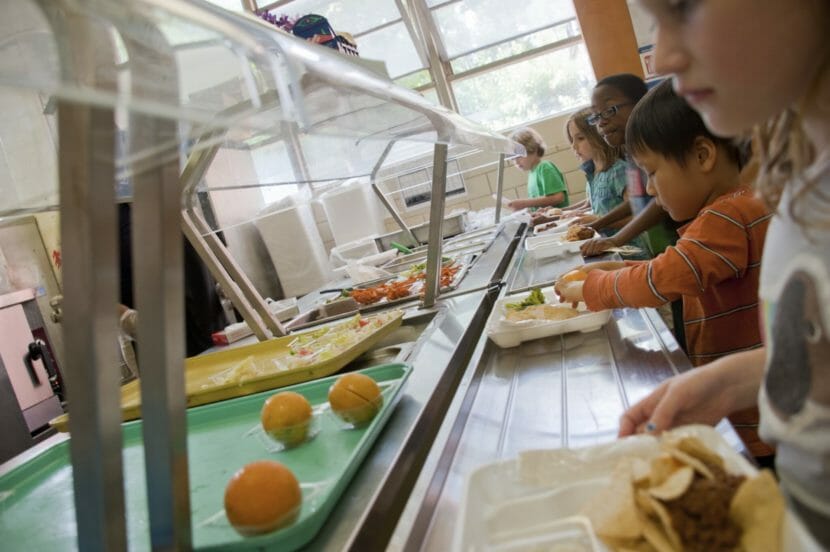
During the pandemic, public schools were able to provide free meals to all students, regardless of income, due to federal waivers. Starting this fall, that access is going away for about half the schools in Alaska that participate in the federal school meal program.
Families attending these schools will return to pre-pandemic ways of getting school meals — apply for free or reduced price meals based on income level, or pay for them.
Jo Dawson, program manager for child nutrition programs at the Alaska Department of Education and Early Development, said the transition will be difficult.
“I don’t want to undersell this. It’s going to be difficult because families who had traditionally applied are not used to applying and some won’t apply. They won’t ask for assistance,” Dawson said.
She said school sites that have traditionally charged for meals saw participation increase during the pandemic.
“Those school sites are definitely concerned at what this transition back to charging for school meals will do to their participation,” Dawson said. “You know, not only to the revenue, but for the students. Do they have the means to access those healthy meals that they have been participating in in the last two years? So it’s certainly a concern.”
Dawson said some students won’t have access to free meals because their families won’t apply or they don’t meet the income threshold. Serving all meals free to all students works well, she said, because it takes barriers away from participation.
“When all of the students partake in the school meals, it’s no longer thought of as a program that someone needs; it’s a program that someone gets. Students don’t want to be identified as needing that meal,” Dawson said.
To ease families through the transition back to pre-pandemic days, schools in the Matanuska-Susitna Borough School District impacted by this change are keeping the costs of meals at the same rates.
“We were very intentional in not increasing our meal prices for this coming year,” said Katherine Gardner, Mat-Su school district associate superintendent who oversees its food service operations.
For elementary schools, breakfast costs about $2.25 and lunch $3.75. At the middle and high schools, breakfast costs $2.75 and lunch $4.75 — the same as pre-pandemic rates.
“We’re very mindful of the increased costs that we’ll have in purchasing goods, purchasing food and supplies. But we also recognize that the lower we can keep those prices, the more access students have to those meals,” Gardner said.
Gardner said the district plans to ramp up its communication to families about the changes to the school meal program as the school year approaches.
“It’s really important that they fill out that free and reduced application. We would encourage all of our families to take a look at the application and fill it out. Some people may not think they qualify, but they do. That free and reduced application and status not only helps with access to meals, but it helps for additional support for student programs,” Gardner said.
About half the schools in Alaska will continue to serve free meals to all
About half the schools in Alaska that participate in the national school meal program, including a quarter of the schools in the Mat-Su school district, will not see any difference in their school meal program this coming school year. They’ll continue to serve all meals free to all students through the federal Community Eligibility Provision program, which includes schools where at least 40% of students are eligible based on income or other factors.
“Nothing will change in our district,” said Amanda West, food service director for Lower Kuskokwim School District, regarding student access to free meals.
The district serves about 4,000 students in 28 schools. Most students participate in the school meal program, West said. What will change is how the food is served, “We’re no longer packing it to-go for families. We’ll be serving it in the cafeterias. We’re just going back to what we were doing before, serving kids regular meals.”
Ripple effect of free school meals going away
The benefits linked to a universal free school lunch program – food security and academic performance – will likely be impacted when it goes away, said Mary Kopriva, health economist at the Institute of Social and Economic Research at the University of Alaska Anchorage.
“Families are already facing increased food insecurity because of increased prices. Taking away these universal free lunches just exacerbates that,” Kopriva said.
Kopriva said a working research paper that recently came out suggests that taking away universal free lunch may make inflation worse. The paper showed that universal school lunch programs actually helped to reduce grocery prices for everybody by reducing people’s grocery expenditures.
“Stores respond to that reduced demand by reducing prices. So if we see universal lunch programs going away then we will see that increased demand to grocery stores, which could actually heighten inflation for all as well. So we could see this actually exacerbate inflation too potentially, which then again, would have these ripple down effects of increased food insecurity,” Kopriva said.
Another possible impact of free school meals going away, Kopriva said, is families buying lower quality food.
“Households who are getting these universal school lunches are spending less on groceries overall. And they’re also able to increase the quality of the food that they’re getting a little bit, so they’re mainly having healthier options. So, it’s possible that we could see some effects on overall health in that dimension as well.”


